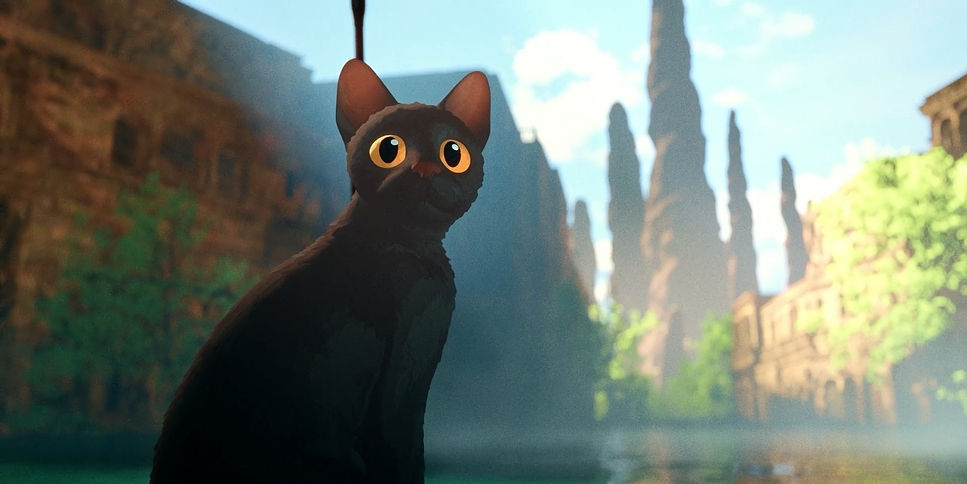Flow: A Fantastical Feat of Indie Animation
- Jamie Marie Torres
- Mar 30
- 4 min read

Animation is underappreciated in Hollywood, and so is independent film. Independent animation? It is as rare as a needle in a haystack. That is if you had to dig a tunnel through a brick wall, Shawshank Redemption style, to get to the haystack.
The 2024 animated feature Flow had everything going against it by its genre alone. It has now made much history, gaining momentous firsts in many fields.
Flow is a dialog-less film made on Blender, a free, open-for-source, 3D computer graphics software, made with a budget of only 3.7 million dollars by filmmakers from the small northern European country of Latvia. The film's director, Gints Zilbalodis, began work on Flow in 2019, along with co-writer Matīss Kaža. On paper, there was no reason for this film to be the sensation it is.
But just this month, Flow made history by becoming the first film from Latvia ever to be nominated for and win an Academy Award for Best Animated Feature. Currently, it has made 36 million in the global box office.
But beyond the accolades, Flow is a stunning feature that makes a piece of art from the barest of tools and a feat of independent filmmaking. Flow is a masterpiece of hope and the survival of kindness. It is a film that is equally beautiful and quaint, and it shows the need for community and kindness in the world in trying times. In simple terms, Flow is nothing short of a wonder, a visual spectacle, and a narrative miracle. Five little animals represent the survival of hope and humanity.

Flow centers around a cat trying to survive a post-apocalyptic flood. Stuck in a boat with a capybara, a ring-tailed lemur, a yellow labrador retriever, and a secretary bird, the cat must learn to survive in this new and confined setting.

The film recorded the real animal counterparts for this film, which is what initially attracted them. The capybara was not a very cooperative actor, so it was recast with a baby camel. Actors are divas, no matter the species. Shocker.
The stars of the film—the animals—can communicate the only way they know how through a series of sounds and body language. This works in the film's favor because Flow’s nonverbal narrative gives each animal life and personality without making them cheesy, cartoonish animals from children's cartoons.
Along their journey, the animals find their places in the boat. The bird mans the rudder, the labrador retriever attempts to instigate play, the lemur collects trinkets in a basket, and the capybara is just… there. The only capybara remained the peacekeeper, fitting for the only herbivores on the boats' docile nature. Zilbaldis and Kaža really took the realism up a notch, taking the primal qualities of each species and anthropomorphizing them for the film.

As previously stated, Flow is a wordless film with all animals and no verbal dialogue. It’s strange to say, but one of the best things about this film is the design of its diegetic sound. Diegetic sound—a sound that originates from the world of the film— is the simple sound of nature; the creatures, the ocean, and even the whale in this film sing the beauty of nature for the audience. This leaves more room for the visuals to speak, and the character is told through the animal's primal movements and behaviors.
Of course, the best thing about animation is the endless potential of the art style, and the visuals of Flow are to be admired in their entirety. At first glance, Flow’s design is similar to a choose-your-own-adventure game, much like the Playstation game Stray. But the more into the film you get, the more you see that Flow's 3D animation style takes a barren world and makes it beautiful, even bordering on philosophical. Very rarely can scenery speak like it does in this film.

The film's physical setting—an ancient ruin rapidly flooding—is designed to be large, ancient, and intrepidly rising. But as the water level rises, nature moves back in. The whale swims through the stone skyscrapers with ease, and schools of fish make small structures their home. Flow is magical realism at its best, keeping the real world beautiful and enhancing it with supernatural elements.

Beyond the animals, Flows' animation style stays grounded within reason. The settings the cat and other animals boat through—a post-human area, forests, and some ancient ruins—are realistic in their desolation. But this grounded realism makes the fantastical elements stand out that much more. It’s a bare-bones narrative elevated by visual style.
Overall, Flow is a wonder. It is a beautiful story whose narrative unfurls in the most magical way possible. Zilbaldis and Kaža have created a delightful tale that defies expectations and animation. Flow tells us that to survive the worst, we require community and kindness. Yes, kindness is a survival tool too.

Bonus Review:
A fun bonus of Flow is the cats. No, not the cat that stars in the film. All around the world, people are sharing pictures and videos of their cats, wholeheartedly entranced by the film. The diegetic sound of Flow will draw cats, but they will park themselves down in front of the screen for the visuals. Its animation style is fetched and- pun not intended - smoothly flowing. For our little friends, it’s got a lot of appeal.









